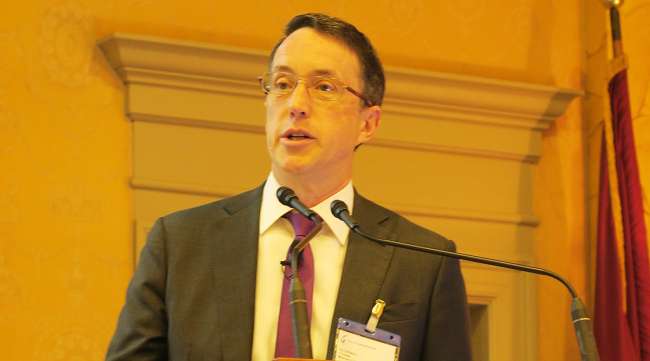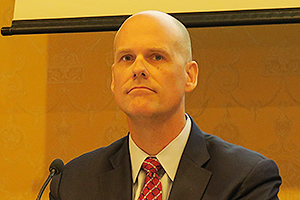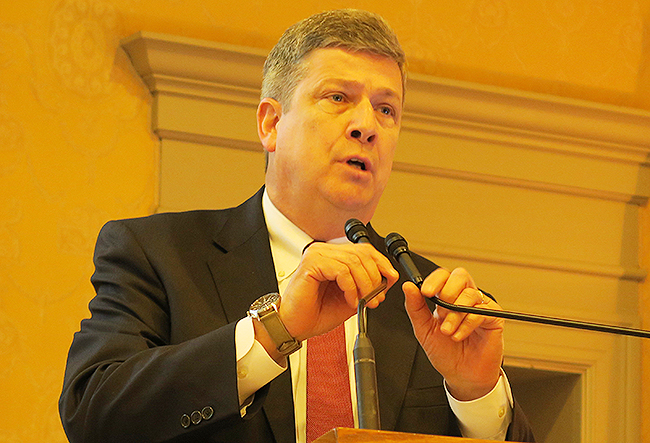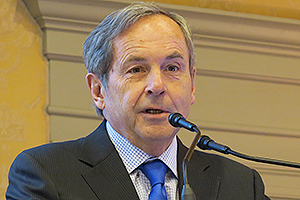Senior Reporter
Experts Discuss Prospect of P3s in Raising Funds for Infrastructure

WASHINGTON — The timing for Infrastructure Week provided stakeholders with an opportunity to discuss what is arguably the toughest challenge facing the $2 trillion infrastructure deal President Donald Trump and congressional Democrats struck in April — how to pay for it.
“The revenue side is the elephant in the room,” said John Porcari, president of advisory services for WSP USA, and a former deputy secretary at the U.S. Department of Transportation, on May 14 during the first day of the two-day P3 Policy and Delivery Summit.

Macomber by Eric Miller/Transport Topics
Indeed, the deal Trump and congressional Democrats announced last month offered no details on funding. While public-private partnerships, or P3s, are one oft-discussed option — particularly at the local and state levels — the P3 industry faces a challenge in gaining the confidence and trust of the public, said Marshall Macomber, senior policy adviser and president of ThinkP3.
“I think if we want to move forward on the P3 front or the investment front, we have to do two things,” Macomber told attendees at the Cosmos Club. “We have to first do policy right, and we have to get the vision right.”
Beth Osborne, director of the nonprofit Transportation for America, added that if the government wants to put more money into programs, it must hold significant accountability for those programs.
“Giving more flexibility for states has led to building things we know we can’t maintain the day we build it,” Osborne said. “That does not build confidence on the part of the American taxpayer.”

John Porcari, president of advisory services for WSP USA, by Eric Miller/Transport Topics
Porcari said that part of the national policy issue is making sure that on the revenue side there’s a regular system in place that measures not just at the state and local levels, but at the federal levels.
“The reality is that the unreliable partner now in private finances is the federal government,” Porcari said. “It used to be the opposite.”
He added, “Unlike some other companies, public-private partnerships in America are not regularized in any way. The biggest impediment to the more widespread adoption of public-private partnerships in America is the inability to price the political risk. In other words, you could get all the way through a process at the city or county level and have the project fall apart at the last minute.”
H.E. David MacNaughton, Canada’s ambassador to the United States, told the group that a victorious candidate he worked in that country had promised to do away with 15 P3 investments. A former adviser to the minister at Canada’s Departments of Transportation and principal secretary to the premier of Ontario, MacNaughton has been credited with helping turn around Ontario’s unpopular P3 investments in infrastructure.

MacNaughton by Eric Miller/Transport Topics
“When we won the election, I was given the responsibility for undoing these evil public-private partnerships,” MacNaughton said. “I renegotiated them, and we turned them into something else, private finance initiatives that we didn’t call P3s.”
He advised that for private investments to be successful government agencies must eliminate cost overruns, standardize documents, establish government competence and transfer risk from the public to private sector. But, he added that his work on the program required “political courage” and was not for the “faint of heart.”
Osbourne noted that, with voters, it’s all about the perceived benefits. “What I find is that when you hear people arguing about money, it’s because they’re not excited about funding the thing you’re talking about,” she said. “Give me the tax that people would be super excited to pay, and then I’ll tell you what they’re going to buy. And they wonder why that doesn’t work. So let’s get people excited about what they’re going to get for this, rather than give me your money and we’ll spread it around in a politically satisfying way.”

